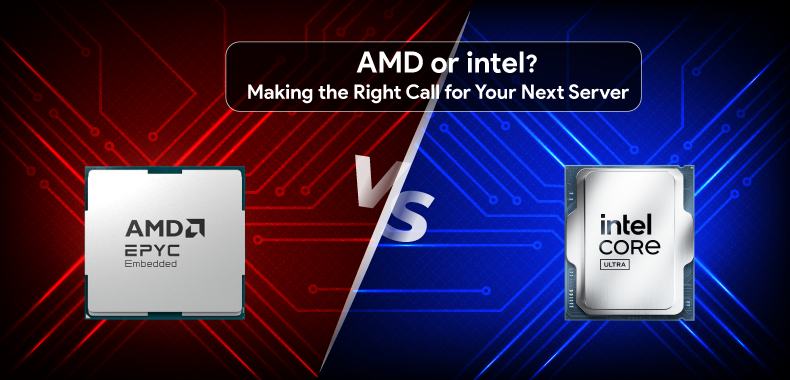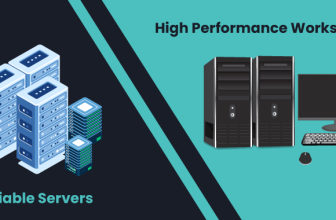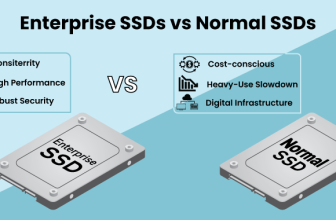
Selecting a perfect server processor is one of the most important decisions that will impact any IT deployment. Server CPUs set the performance, scalability, and long-term ROI for any enterprise, data center, or virtual workload support, and the high-performance computing field, like artificial intelligence. In this blog, we compare the twin giants of the server processor world: AMD EPYC versus Intel Xeon. The two platforms are set up with completely different strengths and philosophies behind their architecture. For years, Intel Xeon processors held the commanding position in the market, but these last few years, AMD EPYC processors have gained a lot of ground with their courageous innovation and world-class performance. Let us look at both in detail and understand which might be better for your business or technical needs.
What is the AMD EPYC Processor?
The AMD EPYC processor family is AMD’s flagship line of server CPUs, launched in 2017 during AMD’s re-emergence in the data center space. EPYC processors are based on AMD’s highly efficient Zen architecture in its fourth generation. The distinguishing factor that makes EPYC processors stand out is their chipset design; each processor consists of multiple interconnected dies united in a single package so that AMD can offer more cores for less cost and power consumption. The latest EPYC series, code-named Turin, boasting Zen 5c architecture, supports top-tier features like DDR5 memory, PCIe 5.0, and up to 192 cores per socket. EPYC further satisfies complete memory encryption and enhanced virtualization, carving a niche in cloud platforms, enterprise workloads, and AI processing. Another distinguishing design element for AMD EPYC servers is their power efficiency. They offer a sliver of performance for each watt when compared to many competing Intel models. Focusing on scalability and memory throughput, EPYC processors are designed for modern-day computing.
What is the Intel Xeon Processor?
Intel has been a name, owing to the Xeon processor family, since it was formed around two decades ago. Known for their robust reliability and compatibility with a software ecosystem and mature development tools, Xeon processors have been supporting everything from legacy servers to next-generation AI workloads. Intel’s new generation server processors follow the Sapphire Rapids architecture, built on an Intel 7 process. The set comprises Xeon Platinum, Gold, and Silver series processors, which cater to different levels of workloads. Many powerful Xeon processors go up to 60 cores and 120 threads, with advanced memory support and hardware accelerators for AI and crypto. Their next generation, however, code-named Sierra Forest, launched recently, includes a version that can take the core count up to 288. Intel, by contrast, is strong in integrated technologies like Intel Deep Learning Boost, QuickAssist Technology (QAT), and SGX for security. Xeons are typically selected first by organizations running workloads having a certified application stack, consistent performance, and industry-specific integrations.
AMD EPYC vs Intel Xeon: Key Features
Let’s break down the technical aspects to distinguish the AMD EPYC and the Intel Xeon
Core and Thread Count
Based on raw computing, Xeon CPUs now stand superior with a core count of an Intel processor at 288, enabling the greatest Intel Xeon performance. EPYC processors, like the powerful 9965 model, max out at 192 cores, which primarily makes them suited for highly parallel operations and core-heavy applications.
Memory Support
Memory architecture is one of the key aspects affecting performance. AMD EPYC supports 12 channels of memory per socket, giving it greater overall memory bandwidth and capacity. Whereas Intel Xeon processors support 8 channels per socket and suffice for the majority of use cases.
Power Efficiency
With its 5nm process, AMD EPYC processors offer a large performance per watt advantage over Intel Xeon processors, which are manufactured under a 10nm process. This means that EPYC servers use less power for performance that is equal to or better than Intel servers and lower the overall operational expense in larger data centers.
PCIe Lane Availability
AMD EPYC processors offer a massive 128 PCIe Gen 5.0 lanes per socket, making them extremely friendly in terms of I/O requirements. This would be important for GPU, NVMe storage, or network connectivity in a high-performance setup. The Xeon processors for workstations, W-2400 and W-3400 series, can provide up to 112 Gen 5 PCIe lanes. On the other hand, Intel Xeon 6 CPUs having P-cores can provide up to 176 Gen 5 PCIe lanes in dual-socket server systems.
Scalability
Intel Xeon used to win the multi-socket scale contest, averaging on the dual, quad, and even octa-socket systems. With that, AMD has made huge strides, and now modern EPYC platforms work elegantly with dual- and quad-socket configurations. Real-world workloads today make CD and CA virtually equal in terms of scalability.
Integrated Accelerators
One of the strongholds of Intel is in this area. Xeon already has accelerators for AI inference (DL Boost), data compression (QAT), and matrix operations (AMX) in its CPU. These built-in accelerators thereby augment performance, unlike being hosted on an external GPU or cards.
Security Features
AMD EPYC processors include Secure Encrypted Virtualization (SEV), Secure Memory Encryption (SME), protecting data in use and data at rest, and Secure Root of Trust. These features become extremely valuable in multi-tenant cloud environments. Intel’s security stack comprises SGX, Intel TXT, VT-d, Total Memory Encryption, and QAT for accelerated encrypted workloads. Both are very good when it comes to security; however, in virtualized environments, AMD’s full-chip encryption is more holistic.
AMD EPYC vs Intel Xeon: Technical Specifications
| Feature | AMD EPYC CPUs | Intel Xeon CPUs |
|---|---|---|
| Architecture | Zen 4, Zen 5, Zen 5c (5nm process); modular chiplet design with high core scalability | Sapphire Rapids (Intel 7), Sierra Forest (Intel 3); monolithic and E-core/P-core hybrid options |
| Core Count (Max) | Up to 192 cores in dual-socket setups (Zen 5c series) | Up to 288 cores in dual-socket systems (Xeon 6 Sierra Forest) |
| Thread Count (Max) | Up to 384 threads with Simultaneous Multithreading (SMT) | Up to 576 threads with Hyper-Threading in Xeon 6 models |
| Max Memory Capacity | Up to 6TB per socket | Up to 4TB per socket |
| Memory Channels | 12-channel DDR5 per socket for higher memory throughput | 8-channel DDR5 per socket, optimized for most enterprise workloads |
| PCIe Support | 128 PCIe Gen 5.0 lanes per socket (great for GPUs, NVMe, and networking) | Up to 176 PCIe Gen 5.0 lanes in Xeon 6 dual-socket platforms |
| TDP Range | Ranges from 200W to 400W, depending on the generation and core count | Ranges from 150W to 400W, depending on the socket configuration and model |
| Security Features | SEV, SME, Secure Boot, Secure Nested Paging, Secure Root of Trust | SGX, TME, TXT, QAT, VT-d, and Multi-Key Total Memory Encryption |
| Integrated Accelerators | No integrated accelerators; relies on discrete GPUs and cards for AI and crypto workloads | Includes DL Boost, AMX, QAT, DSA, and other built-in accelerators for AI, encryption, and I/O |
| Process Technology | 5nm (Zen 4/5c), offering high power efficiency and density | Intel 7 / Intel 3, improved efficiency in Xeon 6 (especially E-core variants) |
Use Cases and Workload Suitability
AMD EPYC
- High-Performance Computing (HPC): Due to a high number of cores and more memory channels, EPYC excels in scientific research, simulation, and modeling.
- Cloud Hosting & Virtualization: Due to the high number of threads offered by AMD EPYC, it results in more VMs being consolidated onto each server, thereby reducing the hardware expenditure of the cloud providers.
- Data Analytics and AI Training: In terms of AI training and analytics, EPYC has a huge PCIe bandwidth that draws many GPUs with NVMe storage.
- Green Data Centers: From a lower power consumption perspective, and for maximum efficiency, EPYC has thus found favor in sustainability-oriented projects
Intel Xeon
- Enterprise Applications: Xeon is the perfect voice for high reliability when any heavy I/O transaction load or Intel-optimized software operation needs to be run in the database.
- Security-Sensitive Environments: Encryption is seen at the hardware level to provide security to the application, whereas SGX would hit in some other area.
- Edge Computing and Networking: Intel Xeon is also used in edge deployment and runtime scenarios, but the ecosystem and low-latency features constitute a substantial portion of the solution.
- Legacy Systems Compatibility: The way to go with the integration is via Xeon if Intel-optimized stacks or an older infrastructure is incorporated.
Conclusion
Both Intel Xeon and AMD EPYC servers are backed by advanced features, architecture, higher core counts, and innovative technologies. The decision rests with your application, your current infrastructure, and your performance expectations. AMD EPYC might top the charts in benchmarks and very likely in core density, power efficiency, and ease of scalability. Now it ceases to be about which is better, so it becomes about which decision is right for workloads. From Intel series-based to power-packed AMD EPYC servers, both ecosystems are placed very well to drive computing forward.







